Three options proposed for reshaping Derbyshire
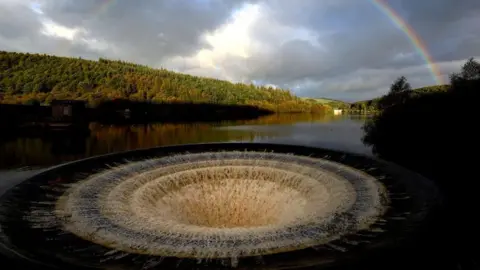 Reuters
ReutersA consultation has been launched on plans to merge Derbyshire's borough and district councils as part of an upcoming shake-up of local government.
The government announced in December it wants to reorganise local authorities in an attempt to streamline services, and councils have been tasked with coming up with proposals.
Derbyshire residents are being asked to pick from three options - all of which split the region into two unitary authorities.
Under the proposals, existing authority areas would merge to form new northern and southern councils - and one of the options put forward would see Amber Valley split between the two.
The consultation will run until 10 August and a final submission to government will be made on 28 November, with the existing councils being scrapped and replaced with two larger authorities in 2028.
Option A
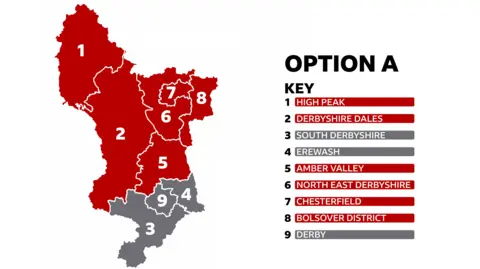
This would involve Amber Valley, Derbyshire Dales, High Peak, Chesterfield, Bolsover, North East Derbyshire merging to form one unitary authority in the north of the county.
Derby City, South Derbyshire and Erewash would combine to establish a second.
Under this proposal, the northern council would have a population of 584,000.
The smaller authority would have a population of 494,000.
Option B
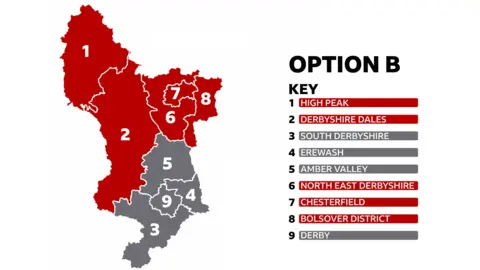
This option would involve Derbyshire Dales, High Peak, Chesterfield, Bolsover, North East Derbyshire merging to form one unitary authority in the north of the county.
Amber Valley, Derby City, South Derbyshire and Erewash would combine to establish a southern authority.
Under this proposal, the southern council would have a population of 622,000.
The smaller northern authority would have a population of 456,000.
Option C
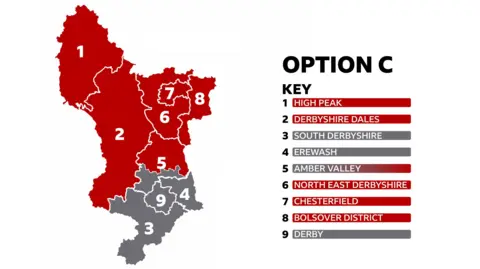
Option C includes a north-south split of the county, with different parishes from Amber Valley joining each of the two councils.
In the northern council, this option would include High Peak, Derbyshire Dales, North East Derbyshire, Chesterfield and Bolsover.
Parts of Amber Valley in this council would include: Shipley, Heanor and Loscoe, Denby, Kilburn, Belper, Hazelwood, Shottle and Postern, Idridgehay and Alton, Ashleyhay, Alderwasley, Ripley, Codnor, Aldercar and Langley Mill, Ironville, Riddings, Somercotes, Alfreton, Swanwick, Pentrich, South Wingfield, Crich, Dethick and Lea, and Holloway.
In this option, the southern council would include Derby City, Erewash, and South Derbyshire.
Parts of Amber Valley in this council would include Kirk Langley, Mackworth, Kedleston, Ravensdale Park, Weston Underwood, Quarndon, Turnditch and Windley, Duffield, Holbrook, Horsley, Horsley Woodhouse, Smalley and Mapperley.
The northern council would have a population of 567,000 whereas the southern council would have 511,000 residents.
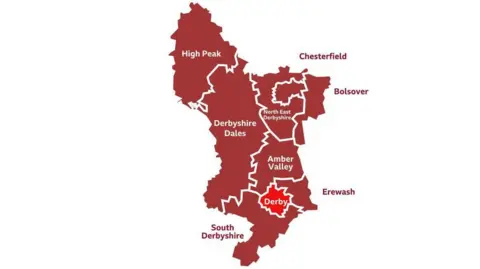
In December, the government published plans to merge areas where there are currently more than one tier of local authority - like Derbyshire.
The English Devolution White Paper also opened the door to boundaries being completely redrawn, and made clear that ministers favour single-tier, or unitary, structures.
At the moment, there are two different systems depending on where you live.
The city of Derby itself is run by Derby City Council - a unitary authority meaning it is in charge of all services in the city boundaries.
Elsewhere, however, there is a two-tiered system.
Derbyshire County Council is in charge of some services - like social care and road maintenance - while smaller district and borough councils take care of things like bin collections and leisure centres.
The government thinks this should be streamlined, hence the proposal to split the county into two unitary authorities.
Former county council leader, Conservative Barry Lewis, was in favour of district and borough councils merging to create a large council with Derby City Council, maintaining its existing boundaries.
But the May elections saw Reform UK take over the administration and it is understood the new leaders in County Hall in Matlock do not support a county-wide model and are generally supportive of the north-south split proposed by the other councils.
The Amber Valley question
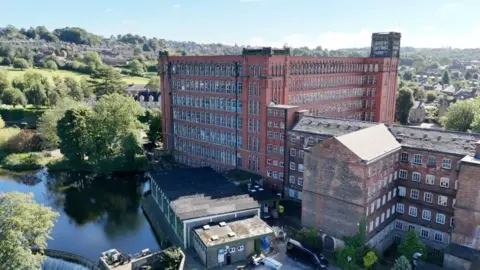
Amber Valley Borough Council (AVBC) leader Chris Emmas-Williams told the BBC option C on the consultation was a non-starter for the borough.
He said Derby City Council could not get a motion passed on how best to proceed where "other districts and boroughs could".
Emmas-Williams said the city council came back with a version of option C in splitting Amber Valley. AVBC negotiated a different split and adopted the option for consultation to "go forward with a case to the government".
"The splitting of Amber Valley, we do not agree to at all," he said.
"The majority of our towns and parishes look to the north and in some instances, Nottingham rather than Derby.
"Most of the towns and surrounding areas are ex-mining areas so it's something that those places have to been close to over the years and that's why a lot of the residents here are leaning towards the north."
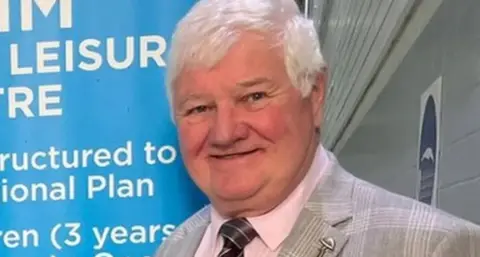 LDRS
LDRSAsked why option C on splitting the borough was not the best proposal, Emmas-Williams added: "It's down to the amount of work that would have to be put in over the next two years with all of the different systems with council tax and what not which would be a massive change.
"With the resources we've got we're really struggling to cope with the amount of work we've got to do already as it stands now without the borough being split into two."
The views of people and organisations will feed into the development of final proposals, which must be considered by existing councils and submitted to government by 28 November.
The government will then review the proposals for Derbyshire, and for 20 other county areas across England, before making final decisions in the summer of 2026.
If the government accepts the proposals for Derbyshire, elections for the new shadow authorities would take place in 2027 and new councils would start to operate by April 2028.
Follow BBC Derby on Facebook, on X, or on Instagram. Send your story ideas to [email protected] or via WhatsApp on 0808 100 2210.
